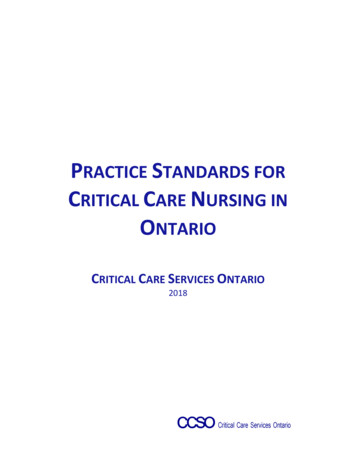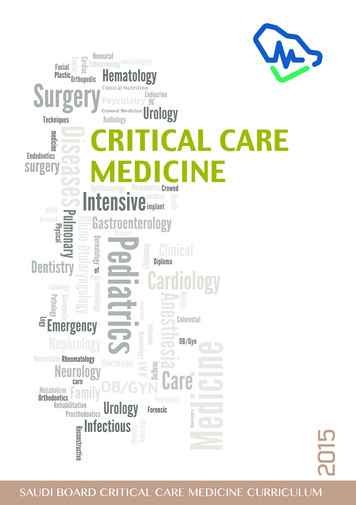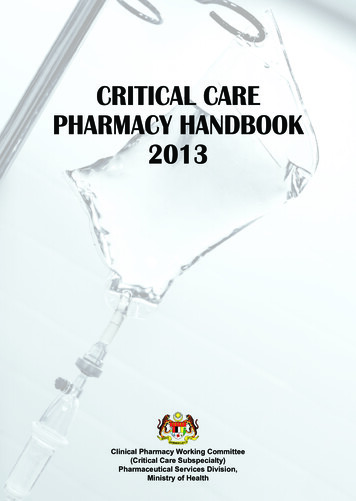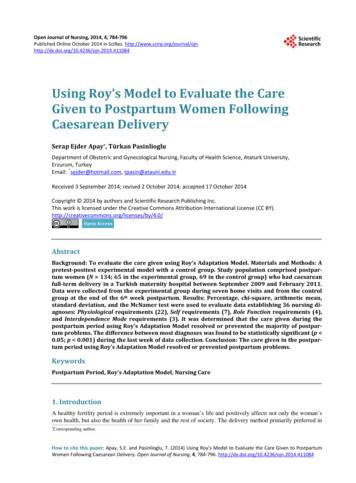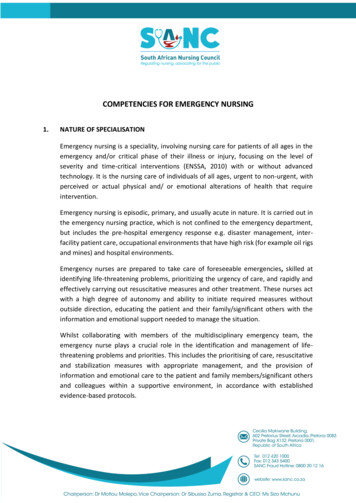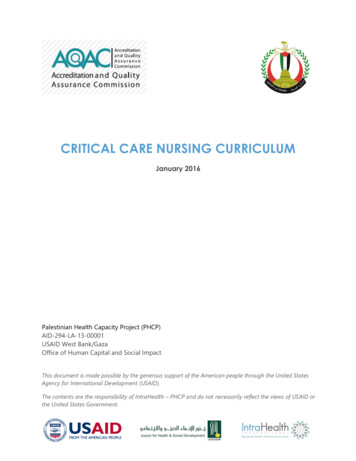
Transcription
CRITICAL CARE NURSING CURRICULUMJanuary 2016Palestinian Health Capacity Project (PHCP)AID-294-LA-13-00001USAID West Bank/GazaOffice of Human Capital and Social ImpactThis document is made possible by the generous support of the American people through the United StatesAgency for International Development (USAID).The contents are the responsibility of IntraHealth – PHCP and do not necessarily reflect the views of USAID orthe United States Government.
ii
CRITICAL CARE NURSING CURRICULUM2016 VersionThe pages that follow represent the combined efforts, commitment and dedication of a groupof professionals to review and revise the Critical Care Nursing Curriculum at Bachelor of Sciencein nursing (BSN) level. The overall aim of this endeavor is to raise standards in Critical CareNursing (CCN) on a national level and meet the health practice setting needs.These efforts have been supported by the Palestinian Health Capacity Project (PHCP), funded bythe United States Agency for International Development (USAID) and implemented byIntraHealth International (IntraHealth) and its partner, Juzoor for Health and Social Development(Juzoor).The aim of this curriculum is to provide a course outline for the critical care nursing componentof the BSN education program under the Accreditation Quality Assurance Commission (AQAC)at the Ministry of Education and Higher Education (MoEHE).It is hoped that the enclosed information will enhance the uniformity and standardization ofcritical care nursing education, according to evidence-based knowledge and practices, andultimately contribute to improving the quality of health care provided to Palestinian patients.iii
TABLE OF CONTENTSPreface . viAcknowledgements . viiIntroduction to this Curriculum . ixOrganization of the Curriculum . ixCritical Care Nursing Theory Section . 11Theory Course Outline . 14Critical Care Nursing Clinical Section . 25CARDIAC. 27CARDIOTHORACIC SURGERY . 27RESPIRATORY . 28HEMATOLOGY. 28GASTROINTESTINAL . 29RENAL . 29WOUND . 29NEUROLOGIC . 29TRAUMA/BURN . 30BEHAVIORAL . 30MULTI-SYSTEM . 31END OF LIFE . 31OPERATING ROOM . 31PROFESSIONAL BEHAVIORS . 31Annexes. 33Annex 1: Guidelines for Nursing Students in Clinical Settings . 34Annex 2: Critical Care Evaluation Criteria: Grading Criteria . 35Annex 3: Case Study Outline . 37Annex 4: Description of the Experience in the Dialysis Department. 39Annex 5: Description of the Experience in the Operating Room (OR) . 40Annex 6: Critical Care Nursing/Clinical Rotations Distribution Example . 41iv
Annex 7: Critical Care Course Simulation Suggestions . 43Annex 8: Critical Care Case Study Examples (Simulation Scenarios). 471.Diabetic Ketoacidosis . 472.Acute Stroke . 513.Acute Myocardial Infarction . 544.Head Trauma . 585.Caring for Post Cardiac Surgery – CABG. 636.Burn . 737.Acute Respiratory Distress Syndrome. 778.Penetrating Chest Injury; Tension Pneumothorax . 859.Hip Fracture . 88Annex 9: Additional thoughts on how to introduce QSEN Competencies through thecurriculum. 90References. 91v
PREFACEIn 2015 the Ministry of Health (MOH), in cooperation with AQAC, unified the teaching standardsfor the BSN. To strengthen the critical care curriculum under the BSN, PHCP through its partnerJuzoor, in cooperation with the MoEHE/AQAC and the MOH’s Director General of Education inHealth, updated the critical care nursing curriculum with input from both local and externaltechnical specialists to be in line with the national updates of the Nursing Standards.The following approach was adopted: A Technical Working Group (TWG) championed by the Director General of Education inHealth was set up to review the existing national curriculums in critical care and reviewthem. A senior international consultant was contracted to review, adapt and consolidate thereview by the TWG in line with international standards and competency frameworks andthe latest evidence-based knowledge and practices. The updated curriculum was disseminated to all the Deans of the nursing schools forreview The comments from the national and international reviews were shared and discussedwith the TWG and finalized. The finalized draft was submitted to and approved by the MoEHE/AQAC and the MOHDirector General of Education in Health.The contents of this curriculum and further instructions related to the critical care nursing maybe clarified or expanded upon by the MoEHE/AQAC, in accordance with their mandate, throughissuance of specific written communication and periodic notices specifically related to: Ensuring that the evidence-based concepts and practices are better reflected throughoutthe curriculum; Critically reviewing the competencies expected of BSN graduates in critical care conceptsand skills; Promoting dialogue between academic institutions and nurses in the service institutionsthat serve as clinical training sites for BSN students, particularly for critical care nursing; Reviewing the teaching methods used to deliver the curriculum; and, Providing faculty development opportunities for the academic and clinical instructorswho teach the critical care curriculum.vi
ACKNOWLEDGEMENTSThis curriculum could not have been developed without valuable contributions from severalPalestinian nurse educators and health professionals and experts who gave of their precioustime and expertise.The following individuals are hereby acknowledged for significant support and overseeing theprocess of preparation, writing and reviewing this curriculum: His Excellency Dr. Jawad Awad, Minister of Health, for his overall leadership of the healthsector and commitment to improving the health of all Palestinians His Excellency Dr. Sabri Saidum, Minister of Education, and Higher Education , for hisoverall leadership of the education sector and commitment to improving the nationaleducation standards Dr. Mohammad Al Sbou’, Director of Accreditation Quality Assurance Commission for hisoverall leadership and his commitment to improving the national education standards. Dr. Amal Abu Awad, Director General of Education in Health and Dean of Ibn SinaCollege for Health Sciences, PMOH for her significant support and contribution indeveloping the Curriculum and overall leadership of the health education andcommitment to improving nursing education standards and competencies. Dr. Deborah Becker, International Consultant, for her significant contributions indeveloping the Curriculum. Dr. Aidah AL Kissi, Technical Working Group member, Al Najah University for hersignificant contributions in developing and reviewing the Curriculum. Ms. Etaf Maqboul, Technical Working Group member, Bethlehem University for hersignificant contributions in developing and reviewing the Curriculum. Ms. Maha Tarayrah, Technical Working Group member, Augusta Victoria Hospital for hersignificant contributions in developing and reviewing the Curriculum. Mr. Ibrahim Talbishi, Technical Working Group member, Ibn Sina College for HealthSciences for his significant contributions in developing and reviewing the Curriculum.The following Juzoor team provided technical, moral and administrative support for thedevelopment of the curriculum: Dr. Salwa Najjab, Executive Director. Ms. Dina Nasser, Health Advisor Ms. Maha Khatib, Technical Specialist Education and Credentialing Ms. Stephanie Hansel, Technical specialistThe Palestinian Critical Care Nursing Faculty members for their review and endorsement of thecurriculum and their contribution with case-study scenario examples attached to the curriculum:vii
Mr. Ali Batran, Hebron University Mr. Baha’ Alassoud, Hebron University Mr. Jameel Shqirat, Al Makassed Hospital Nursing College Ms. Naila Hejaij, Al Makassed Hospital Nursing College Mr. Imad Asmar, Birzeit University Dr. Basma Saleem Salameh, American Arab University Mr. Osaid Rasheed, Al Quds Universityviii
INTRODUCTION TO THIS CURRICULUMTwo sections are included: theory and clinical course outlines. Each course outline describescredit hours, placement, pre-requisites, and co-requisites courses.This Curriculum provides a detailed guide for the content of critical care nursing across thecourse.Primary users of this document are critical care nursing faculty members and clinical instructors.Secondary users are undergraduate nurses.Faculty members and clinical instructors should be thoroughly familiar with the curriculum ofthe critical care course description, teaching and learning methods, teaching aids, grading andevaluation process.Education facilities and course coordinators will find this Curriculum useful to further developmaterials and set the teaching methods for the critical care nursing course. Other nursingeducators may find this Curriculum useful as a model for adaptation in other nursing teachingcourses as well.Organization of the CurriculumThe Curriculum is divided into three sections:Section 1: Critical Care Nursing Theory Section: This section outlines the overview anddescription of the theory section that takes place in class, educator’s teaching plan, time needed,page numbers to the textbook1 that covers details of each topic, and when to set the examsthroughout the course.Section 2: Critical Care Nursing Clinical Section: This section is a co-requisite to the critical carenursing theory section. This section outlines the overview and description of the clinical section,teaching methods, critical care units rotation, clinical evaluation and grading. During the clinicalsection the student is following his/her specialized nursing clinical competencies booklet2designed for nursing undergraduate students. It contains all procedures that students areexpected to perform safely throughout their training period. It provides the student with arecord of skills performed during his/her clinical practice. It helps the student to identify his/herlearning needs and guides instructors and students to clinical learning objectives.1Sole, Klein & Moseley. (2013). Introduction to Critical Care Nursing (6th Edition). US: SaundersCompetency Booklet: a separate record of skills performed during nursing student during her/his clinicalpractice developed by the CC Faculty members.2ix
The booklet enables both students and instructors to cover most of the procedures within anappropriate period. For an accepted level of performance of skills, the booklet is designed tocover each skill in the following three domains:1) Observing2) Participating3) PerformingWhenever a student observes, participates, or performs a certain procedure the instructor willsign in the designated column. Students are expected to remind their instructors about anyprocedure that they did not yet practice.Section 3: The annexes include examples in guidelines for nursing students in clinical setting,evaluation criteria, grading criteria, case study outline, description of the experience in thedialysis department and operation room (OR), student/clinical rotations distribution, simulationsuggestions, case study (simulation scenarios) to be used either in hospitals or simulation labs inthe universities, and additional thoughts on how to introduce Quality and Safety Education forNurses QSEN Competencies through the curriculum.x
CRITICAL CARE NURSINGTHEORY SECTIONxi
CRITICAL CARE NURSING THEORY SECTIONTitle: Critical Care NursingCourse Credits: 4 credit hours TheoryPlacement: Senior yearPre-requisites: Young and Middle Age Adult Health Older Adult HealthCo-requisites:Course Description:Advances in technology and medicine mean that increasing numbers of severely ill patients aresurviving with a corresponding need for intensive nursing care. Critically ill patients are oftenmanaged in an intensive care unit within a hospital where sophisticated equipment is availableto enable frequent monitoring of vital signs, assisted ventilation and, when life-threateningcrises occur, and rapid resuscitation measures. This course focuses on the causes of single andmulti-organ system dysfunction and the human responses to life threatening illness. Nursingcare focused on restoring physiologic and psychological stability to the severely ill client will beexplored. Core concepts of complex pathophysiology, current treatment modalities, and therole nurses perform when providing care to critically ill patients are discussed.Teaching – Learning methods: references 31- Discussion – critical thinking2- Presentation and lecturing3- Role playing and case study reviews4- Assignments5- Activities/ExercisesTeaching aids: will be developed by the educators and instructors1- Blackboard2- Handout3- Scenarios/simulation4- Videotapes5- Computer and LCDGrading and evaluation: Exams and evaluation tools will be developed by educators andinstructors.Sole, Klein & Moseley. (2013). Introduction to Critical Care Nursing (6th Edition). US: Saunders, instructormanual312
First hour exam20%Second hour exam20%Simulation10%Assignment & Activities10%Final hour exam40%Total100%Intended Learning Outcomes:1. Integrate knowledge from nursing and related disciplines into the nursing care plan ofpersons with life-threatening illnesses.2. Identify appropriate documentation of nursing care delivery to the critically ill client and thefamily.3. Identify collaborative strategies with colleagues from nursing, related disciplines andconsumers to develop a comprehensive plan of care for clients experiencing acute trauma or acritical illness.4. Explore practice, ethical, legal and interpersonal dimensions within the trauma/critical caresetting.5. Identify problems for nursing research in trauma/critical care nursing.6. Examine the role of the professional nurse as an advocate for the acute trauma/critically illclient and the client-family unit.Required Textbooks: the following text books had been recommended to be used as the maintext books for General Nursing graduates.Sole, Klein & Moseley. (2013). Introduction to Critical Care Nursing (6th Edition). US: SaundersGoldman, M. (2007).Pocket Guide to the Operating Room (3rd Edition). Philadelphia: Davis.Carlson, K. (2009). AACN Advanced Critical Care Nursing. Saunders. Chapter 14, pages 297318.Recommended Readings:Siegel, M. (2009). End-of-Life Decision Making in the ICU. Clinical Chest Medicine, 30, 181-194.13
Theory Course OutlineWeekNo.1TopicPage #s4TextbookIntroduction to CourseConcepts of critical care and intensive care History of critical care units Unit designs Care Models Goals of Care Understanding principles of Triaging Understanding the role of BLS and ACLSprotocolsPatient & Family Response to Critical CareEthical and Legal Issues in Critical Care4ObjectivesDaily Hours0.5 Describe the benefits and challenges of criticalcare units and intensive careCompare and contrast the needs of familymembers whose patient is in the ICUDescribe ways nurses can support familymembers while the patient is in the ICUDescribe legal and ethical issues that arise incritical care nursingExplain the nurse’s role in ethical and legalsituationsReview scenarios encountered in the ICU, ER,and discuss the ethical and/or legal issuespresentedSole, Klein & Moseley. (2013). Introduction to Critical Care Nursing (6th Edition). US: Saunders142-111.014-231.026-361.5
2Comfort and Sedation Terms Pain, agitation, anxiety, sedation scales Delirium, Dementia signs & symptoms Confusion Pharm and non-pharm therapiesNutritional Support Assessing nutritional status Enteral and Parenteral nutrition Monitoring nutritional status anddetermining if needs are metQSEN Competencies 3&4Shock States: Distributive, Hypovolemic,Cardiogenic & Obstructive Etiology & Pathophysiology Clinical Signs & Symptoms, includinghemodynamics Management – Pharmacologic & Nonpharmacologic Evaluation of Treatment Plan Goals of Care Nursing Care for patients in shock statesHemodynamic Monitoring Components, normal values, how values areobtained or calculated Define pain, discomfort, confusion, agitation,anxiety, comfort and sedationDescribe ways to assess the patient for pain,discomfort, confusion, agitation and anxietyExplain how to use pain & agitation scalesCompare and contrast the causes, clinicalsymptoms and management of Delirium andDementiaDescribe the common pharmacologic and nonpharmacologic management for pain,discomfort, agitation, anxiety, and confusionExplain why nutritional supplementation isnecessary in the critically illDescribe ways to assess and monitor effectivesof nutritional supplementationCompare & contrast benefits and challenges ofparental and enteral nutritionDefine the QSEN competenciesRelate competencies to nursing care of thecritically ill patientList the 4 classifications of shock and the typesof shock found in each classExplain the pathophysiology and progressionthrough each shock stateDefine the goals of care for each shock stateand the nursing care required when managingpatients in shockDescribe the hemodynamic values associatedwith the various shock statesDefine the causes, clinical presentation,diagnostic lab results and management of eachshock stateExplain the concepts of cardiac output, cardiacindex, SVR and how they relate to the1548-752.080-921.0679-6821.0250 – 2873.01.0140-1682.0
Nursing care of the patient with hemodynamicmonitoring Interpreting hemodynamic values inrelationship to shock statesVasoactive Medications Classifications and names of medications,mechanisms of action and dosage ranges,indications for use and intended effects Calculating dosages and infusion rates forvasoactive medicationsQSEN competenciesSafe Medication AdministrationFIRST HOUR EXAMin-line with other courses scheduleIntroduction to Dysrhythmias Review of Conduction System Basics of ECG Interpretation Dysrhythmia:o Identificationo Detectiono Causationo Management/interventions (Refer toACLS protocols) Rapid Response and Code Teamso Roles within these teamso Goals of careQSEN CompetenciesSafe Medication Administration for arrhythmias andassociated sequelaeCardiac Vascular Systems Cardiac assessment, diagnostics Management of ACS/AMI Management of Heart Failure Coronary Artery Bypass Surgery 55 &66 &7 physiologic changes that occur in shock states.Describe how vasoactive medications are usedto improve blood pressure, cardiac output,contractility and reduce SVRCalculate accurate dosages of vasoactivemedications and their infusion rates1.0 Identify components of the conduction systemand the related PQRST of the ECG tracingRecognize normal and abnormal atrial,junctional and ventricular rhythmsIdentify life threatening dysrhythmias andinstitute ACLS protocols as necessaryDiscuss the nurses role in emergency/codesituationsDescribe the role and responsibility of rapidresponse teamsDiscuss how medications are administeredsafely and accurately in high stress and/orchaotic situations94-1383.0220-2262.0Explain the progression of coronary arterydisease and ways to determine the extent ofdisease presentExplain the differences between coronary arterydisease (CAD), Acute Coronary Syndrome289-343162.02.0**Carlson,
QSEN CompetenciesSafe Medication Administration 8SECOND HOUR EXAM8&9Respiratory SystemAirway Management Advanced Principles of Oxygen and Ventilation Oxyhemoglobin Dissociation Curve Supplemental oxygenation; pulse oximetry(ACS), and an Acute MI (AMI)Describe the management of CAD, ACS andAMIDescribe the use of angioplasty and stentplacement in the management of coronaryartery disease and the nursing care requiredwhen managing patients with these proceduresDiscuss when the decision to take a patient fora coronary artery bypass graft (CABG) surgery isnecessaryExplain the preoperative responsibilities of thenurse when preparing a patient for surgeryDescribe the goals of care and nursingresponsibilities in the immediate post-operativeperiod after CABG surgeryDescribe how the nurse and medical teammonitors the patient’s cardiac index, fluid statusand cardiac function, and overall response tobypass surgery and responds to changes.297-318.2.01.0 Acute Respiratory Failure Acute Respiratory Distress Syndrome Acute Pneumonia Ventilator Associated Pneumonia Describe how the pulse oximeter reflects theoxyhemoglobin dissociation curve and how itreflects where the patient’s oxygenation statusis and its relationship to successful oxygenationDiscuss the various types of oxygen deliverydevices used and the situations where these areappropriateDescribe the nursing care of the patient inacute respiratory failureExplain how Acute Respiratory DistressSyndrome differs from Pulmonary EdemaDiscuss the management of the patient withPneumoniaDescribe the management of the patient with a17400-4291.02.01.0
Pulmonary Embolismpulmonary embolismSafe Medication Administration practices910Mechanical Ventilation Principles of mechanical ventilation Ventilator modes and settings Ventilator changes effect on blood gases/Weaning Complications of ventilator ABG analysis QSEN Competencies as they relate to pulmonarydisease, mechanical ventilation and associated careRenal SystemRenal Failure Etiology of Acute Kidney Injury/Disease(AKI/AKD) Management of AKI Renal Replacement Therapieso Hemodialysiso Continuous Renal ReplacementTherapies (CRRT)o Peritoneal DialysisFluid & Electrolyte Management Maintenance of fluid balance Hyper & Hypo: identification, management andmonitoringo Na , K , Ca , Mg QSEN CompetenciesSafe Medication Administration related toalterations in kidney function Explain when mechanical ventilation is neededand how the ventilator modes and settings aredetermined.Identify normal and abnormal values for ABGanalysis; respiratory acidosis, respiratoryalkalosis, metabolic acidosis and metabolicalkalosisDiscuss the oxygenation changes in ARF, ARDSand Pneumonia and relate them to the ABGsand mechanical ventilation needsDescribe the multiple causes for thedevelopment of acute kidney injury or diseaseDescribe the signs and symptoms anddiagnostic values monitored to identifyAKI/AKDExplain the management of AKI including theuse of renal replacement therapiesDiscuss the importance of fluid and electrolytemanagement in the critically illDescribe the nursing care of a patient withAKI/AKD or fluid management issues183.0432-4583.01.0
11Simulation Sessions1.0Some examples available in the annexes can beused11Hematologic and Immune Disorders Solid Organ Transplantation Safe Medication Administration related topolypharmacy for immunocompromised patients 12Endocrine SystemEndocrine Disorders Hyperglycemia Monitoring and Treatment Diabetic Ketoacidosis Preventing and Treating HypoglycemiaSafe Medication Administration focused on giving Describe commonly encountered bleedingdisorders in ICU patients and how they aretreatedDiscuss reasons for immunocompromisedpatients to be cared for in the ICUExplain the nurses role in infection controlList the types of solid organ transplantsconducted in Palestinian HospitalsDescribe the pre and post-operative nursingcare of transplant patientsExplain why hyperglycemia occurs in critically illpatients and methods of assessing for it.Describe what DKA is and how it’s treatedDiscuss the nurses role in managing a patient’sglucose level; both high and low460-5011.0658-6732.0543-5862.0Describe the role of the liver and the multiplecauses of liver failureDescribe why patients are placed on pepticulcer prophylaxis and what pharmacologicagents are used502-5421.0IV insulin followed by subcutaneous insulin,reducing potassium levels and avoidinghypoglycemia13Gastrointestinal Concerns in the ICU Acute Liver Failure Gastrointestinal bleeding Pancreatitis 19
14Neurologic System Increased ICPStroke ManagementSafe Medication administration related to providingthrombolytic medications for ischemic strokes,providing oral medications in patients withdysphagia and providing treatments for increasedICP Identify what ICP measures and the normalvalues and waveforms for intracranial pressureDescribe methods for monitoring ICP and bothinvasive and non-invasive approaches toreducing ICP levelsDescribe the causes of acute stroke – ischemicand hemorrhagic and how each is diagnosedand managedDiscuss the potential presentation of someonehaving a stroke; clinical signs and symptomsDescribe the nursing care of the patient with anacute stroke including pharmacologic and nonpharmacologic approaches to care20345-3993.0
15Trauma-related Injuries Traumatic Injury – Penetrating & Blunt Burns Safe Medication Administration practices especiallyrelated to administering pain medications QSEN competencies related to the care of traumapatients and burn patients 16Operating Room Patient Care in the Operating Suite Identifying the correct patient for the correctsurgery; Time out Infection Control measures taken in the ORsuite Safety measures employed in the OR suite Roles of the circulating nurse and scrub nurse Descri
Feb 22, 2016 · CRITICAL CARE NURSING CURRICULUM 2016 Version The pages that follow represent the combined efforts, commitment and dedication of a group of professionals to review and revise the Critical Care Nursing Curriculum at Bachelor of Science in nursing (BSN) level. The overall aim of this endeavor is to raise standards in Critical Care

